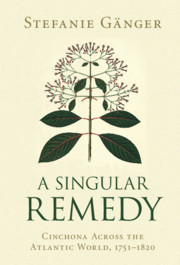Refine search
Actions for selected content:
10301 results in History of science: general interest
Innovation in a crisis: rethinking conferences and scholarship in a pandemic and climate emergency
-
- Journal:
- The British Journal for the History of Science / Volume 53 / Issue 4 / December 2020
- Published online by Cambridge University Press:
- 18 November 2020, pp. 575-590
- Print publication:
- December 2020
-
- Article
-
- You have access
- Open access
- HTML
- Export citation
Natural history in the physician's study: Jan Swammerdam (1637–1680), Steven Blankaart (1650–1705) and the ‘paperwork’ of observing insects
-
- Journal:
- The British Journal for the History of Science / Volume 53 / Issue 4 / December 2020
- Published online by Cambridge University Press:
- 29 October 2020, pp. 497-525
- Print publication:
- December 2020
-
- Article
-
- You have access
- Open access
- HTML
- Export citation
Introduction
-
- Book:
- A Singular Remedy
- Published online:
- 02 October 2020
- Print publication:
- 15 October 2020, pp 1-29
-
- Chapter
- Export citation
Index
-
- Book:
- A Singular Remedy
- Published online:
- 02 October 2020
- Print publication:
- 15 October 2020, pp 232-238
-
- Chapter
- Export citation
A Note on Source Material
-
- Book:
- A Singular Remedy
- Published online:
- 02 October 2020
- Print publication:
- 15 October 2020, pp xii-xiii
-
- Chapter
- Export citation
Acknowledgements
-
- Book:
- A Singular Remedy
- Published online:
- 02 October 2020
- Print publication:
- 15 October 2020, pp ix-xi
-
- Chapter
- Export citation
A Note on Language and Translation
-
- Book:
- A Singular Remedy
- Published online:
- 02 October 2020
- Print publication:
- 15 October 2020, pp xiv-xiv
-
- Chapter
- Export citation
Bibliography
-
- Book:
- A Singular Remedy
- Published online:
- 02 October 2020
- Print publication:
- 15 October 2020, pp 184-231
-
- Chapter
- Export citation
1 - Origin Stories
-
- Book:
- A Singular Remedy
- Published online:
- 02 October 2020
- Print publication:
- 15 October 2020, pp 30-53
-
- Chapter
- Export citation
Conclusion
-
- Book:
- A Singular Remedy
- Published online:
- 02 October 2020
- Print publication:
- 15 October 2020, pp 179-183
-
- Chapter
- Export citation
Contents
-
- Book:
- A Singular Remedy
- Published online:
- 02 October 2020
- Print publication:
- 15 October 2020, pp v-vi
-
- Chapter
- Export citation
5 - Harvests of Change
-
- Book:
- A Singular Remedy
- Published online:
- 02 October 2020
- Print publication:
- 15 October 2020, pp 147-178
-
- Chapter
- Export citation
Copyright page
-
- Book:
- A Singular Remedy
- Published online:
- 02 October 2020
- Print publication:
- 15 October 2020, pp iv-iv
-
- Chapter
- Export citation
3 - Community of Practice
-
- Book:
- A Singular Remedy
- Published online:
- 02 October 2020
- Print publication:
- 15 October 2020, pp 91-119
-
- Chapter
- Export citation
A Note on Weights, Currencies and Measures
-
- Book:
- A Singular Remedy
- Published online:
- 02 October 2020
- Print publication:
- 15 October 2020, pp xv-xvi
-
- Chapter
- Export citation
4 - Febrile Situations
-
- Book:
- A Singular Remedy
- Published online:
- 02 October 2020
- Print publication:
- 15 October 2020, pp 120-146
-
- Chapter
- Export citation
Illustrations
-
- Book:
- A Singular Remedy
- Published online:
- 02 October 2020
- Print publication:
- 15 October 2020, pp vii-viii
-
- Chapter
- Export citation
2 - The Demands of Humanity
-
- Book:
- A Singular Remedy
- Published online:
- 02 October 2020
- Print publication:
- 15 October 2020, pp 54-90
-
- Chapter
-
- You have access
- HTML
- Export citation
The ciné-biologists: natural history film and the co-production of knowledge in interwar Britain
-
- Journal:
- The British Journal for the History of Science / Volume 53 / Issue 4 / December 2020
- Published online by Cambridge University Press:
- 14 October 2020, pp. 527-551
- Print publication:
- December 2020
-
- Article
-
- You have access
- Open access
- HTML
- Export citation

A Singular Remedy
- Cinchona Across the Atlantic World, 1751–1820
-
- Published online:
- 02 October 2020
- Print publication:
- 15 October 2020
